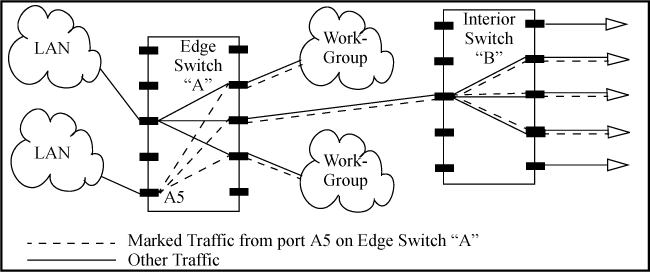Assigning an 802.1p priority for a global IP-diffserv classifier
One of the best uses for this global QoS packet-marking option is on an interior switch to honor (continue) a policy set on an edge switch. The IP-diffserv classifier enables selecting incoming packets having a specific DSCP and forwards these packets with the desired 802.1p priority. For example, if an edge switch A marks all packets received on port A5 with a particular DSCP, you can configure a downstream (interior) switch B to handle such packets with the desired priority (regardless of whether 802.1Q-tagged VLANs are in use).

To do so, assign the desired 802.1p priority to the same codepoint that the upstream or edge switch assigns to the selected packets. When the downstream switch receives an IP packet carrying one of these codepoints, it assigns the configured priority to the packet and sends it out the appropriate outbound port queue. (The packet retains the codepoint it received from the upstream or edge switch). You can use this option concurrently with the diffserv DSCP Policy option, as long as the DSCPs specified in the two options do not match.
Different applications may use the same DSCP in their IP packets. Also, the same application may use multiple DSCPs if the application originates on different clients, servers, or other devices. Using an edge switch enables you to select the desired packets and mark them with predictable DSCPs that can be used by downstream switches to honor policies set in the edge switch.
The codepoint is configured with an 802.1p priority in the DSCP table. (Codepoints configured with
No-overrideare not used.)The codepoint is not configured for a new DSCP policy assignment.
Thus, the switch does not allow the same incoming codepoint (DSCP) to be used simultaneously for directly assigning an 802.1p priority and also assigning a DSCP policy. For a given incoming codepoint, if you configure one option and then the other, the second overwrites the first.